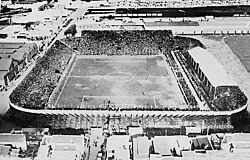Estadio Racing Club
| Estadio Racing Club | |
Estadio Alsina y Colón | |
 The stadium in 1939 | |
 | |
| Address | Alsina and Colón |
|---|---|
| Location | Avellaneda, Argentina |
| Coordinates | 34°40′03″S 58°22′06″W / 34.6675°S 58.3683°W |
| Owner | BA Great Southern Railway |
| Operator | Racing Club |
| Type | Stadium |
| Genre(s) | Sporting events |
| Capacity | 50,000[1] |
| Field size | 105 x 85 m [2] |
| Surface | Grass |
| Construction | |
| Opened | 1904 |
| Renovated | 1928–29 |
| Closed | December 1946 |
| Demolished | 1948 |
| Tenants | |
| |
The Estadio Racing Club, popularly known as Estadio Alsina y Colón, was an association football stadium in Avellaneda, a suburb of Greater Buenos Aires, Argentina.
It was the home ground of
The stadium was closed in December 1946 to build the Estadio Presidente Juan Domingo Perón which was inaugurated in 1950.
History
After spending some time in other locations, Racing Club returned to Alsina and Colón streets in 1906. The stadium hosted not only football matches but other sporting events. On May 7, 1911, Racing debuted in Primera División playing in "Alsina y Colón" vs San Isidro, becoming the first Racing's top division match held in that venue.[3] By those times, the club built the roof grandstands.[1]
One of Racing's achievements in that stadium was the win over legendary team Alumni 3–1. That was the last season of Alumni in Argentine football so the club disbanded soon after.[4] Racing is considered the "successor" of Alumni due to their successful campaigns in upcoming years during the second decade of the 20th. century. Some journalist state that Racing gave birth to the "creole style", opposing to Alumni's British school that dominated the first years of the century.[5][6]
By those times, the
As football gained more enthusiasts, the club built more grandstands on Alsina and Italia streets to increase the stadium's capacity. In 1913, Argentina played a Copa Lipton match at Racing Club, beating Uruguay 4–0. That same year, Racing achieved its first title in Primera División after beating San Isidro 2–0 in the final match.
Racing also hosted some matches played by English club
On 17 July 1916, the last match of the
Racing Club was the frequent venue for international games until 1918 when GEBA was re-opened. In 1922, the grandstand was built, increasing the capacity to 30,000 spectators. The stadium was refurbished again between 1928 and 1928, increasing its capacity to 50,000 spectators. The stadium grounds, which were owned by the Buenos Aires Great Southern Railway, were acquired by Racing in 1944. Two years later it was granted a loan to build a new stadium made of concrete. The last official match played at Alsina y Colón was on 1 December 1946, when Racing lost to Rosario Central 6–4.[1]
References
- ^ a b c d Racing Club on Viejos Estadios website
- ^ Planillas de Afiliación - Temporada 1927 by Asociación Amateurs de Football on AFA Library
- ^ Argentina 1911 by Pablo Ciullini on the RSSSF
- ^ "Alumni: en el nombre del fútbol" on Clarín, 2003-04-21
- ^ A cien años del primer título de Racing, cuando el fútbol se hizo criollo, Diario Río Negro, 2 Dec 2013
- ^ Fútbol argentino: del deporte de elite al surgimiento de un fútbol criollo by Darío Brenman, La Izquierda Diario, 13 Sep 2018
- ISBN 9504343848
- ^ Copa Newton by José L. Pierrend on the RSSSF
- ISBN 0992967600.
- ^ South America Trip of Exeter City 1914, from La Nación newspaper, compiled by Pablo Ciullini on the RSSSF
- ^ South American Trip of Torino and Pro Vercelli in 1914 by Pedro Varanda
- ^ 1916: once policías para 30 mil hinchas en el primer escándalo del fútbol by Daniel Balmaceda on La Nación, 27 Nov 2018
- ^ "Triste epílogo del Campeonato Sudamericano" on La Vanguardia newspaper, 17 Jul 1916
- David Goldblatt; World Soccer Yearbook; 2002 ISBN 0-7894-8943-0


